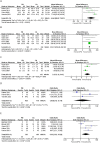Perioperative, functional, and oncological outcomes after cryoablation or partial nephrectomy for small renal masses in solitary kidneys: a systematic review and meta-analysis
- PMID: 38268005
- PMCID: PMC10809601
- DOI: 10.1186/s12894-024-01406-x
Perioperative, functional, and oncological outcomes after cryoablation or partial nephrectomy for small renal masses in solitary kidneys: a systematic review and meta-analysis
Abstract
Aim: This study aims to compare the perioperative, functional, and oncological outcomes of cryoablation (CA) and partial nephrectomy (PN) for managing small renal masses in patients with solitary kidneys. The study seeks to assess the efficacy and safety of both interventions, evaluating their impact on kidney function and their ability to mitigate cancer recurrence.
Methods: Searches were systematically conducted on PubMed, Scopus, EMBASE, SinoMed, and Google Scholar, identifying seven observational studies. Statistical analysis was performed using Stata v.12.0 and Review Manager version 5.2. Results for dichotomous variables are expressed using odds ratios, and weighted mean differences are used for continuous variables.
Results: Our findings revealed that patients undergoing CA experienced significantly shorter operative time (p < 0.0001), reduced estimated blood loss (p < 0.00001), a shorter length of stay (p = 0.0001), and fewer postoperative complications (p = 0.02) compared to those undergoing PN. Although the CA group exhibited a lower transfusion rate (p = 0.69) compared with the PN group, the difference was not statistically significant. The combined data analysis demonstrated a significantly lower increase in serum creatinine levels after surgery in the CA group compared with the PN group (p = 0.003). Similarly, there was a noteworthy decrease in the estimated glomerular filtration rate after surgery in the PN group compared with the CA group (p < 0.0001). While not statistically significant, the CA group showed a lower postoperative dialysis rate (p = 0.11). Regarding oncological outcomes, the analysis revealed no significant differences between CA and PN concerning local recurrence (p = 0.2) and distant metastasis (p = 0.12), respectively.
Conclusions: Our analysis indicates comparable efficacy between PN and CA in controlling tumour recurrence and metastasis. However, CA is associated with superior preservation of renal function, significantly enhanced perioperative outcomes, and fewer postoperative complications. Based on our data, it can be inferred that the scope for applying CA might be expanded to encompass more patients seeking a less invasive treatment option.
Keywords: Cryoablation; Meta-analysis; Partial nephrectomy; Small renal masses; Solitary kidney.
© 2024. The Author(s).
Conflict of interest statement
The authors declare no competing interests.
Figures




Similar articles
-
Partial Nephrectomy Versus Radical Nephrectomy for Clinical T1b and T2 Renal Tumors: A Systematic Review and Meta-analysis of Comparative Studies.Eur Urol. 2017 Apr;71(4):606-617. doi: 10.1016/j.eururo.2016.08.060. Epub 2016 Sep 7. Eur Urol. 2017. PMID: 27614693
-
Radiofrequency ablation versus partial nephrectomy for treatment of renal masses: A systematic review and meta-analysis.Kaohsiung J Med Sci. 2015 Dec;31(12):649-58. doi: 10.1016/j.kjms.2015.09.007. Epub 2015 Nov 6. Kaohsiung J Med Sci. 2015. PMID: 26709228 Free PMC article.
-
Laparoscopic renal cryoablation versus laparoscopic partial nephrectomy for the treatment of small renal masses: a systematic review and meta-analysis of comparative studies.J Laparoendosc Adv Surg Tech A. 2014 Jun;24(6):403-10. doi: 10.1089/lap.2013.0550. J Laparoendosc Adv Surg Tech A. 2014. PMID: 24914926
-
Focal therapy versus robot-assisted partial nephrectomy in the management of clinical T1 renal masses: A systematic review and meta-analysis.Medicine (Baltimore). 2018 Nov;97(45):e13102. doi: 10.1097/MD.0000000000013102. Medicine (Baltimore). 2018. PMID: 30407321 Free PMC article.
-
Robotic versus laparoscopic versus open nephrectomy for live kidney donors.Cochrane Database Syst Rev. 2024 May 9;5(5):CD006124. doi: 10.1002/14651858.CD006124.pub3. Cochrane Database Syst Rev. 2024. PMID: 38721875 Free PMC article.
Cited by
-
Combining Transarterial Embolization and Percutaneous Cryoablation for Early-Stage Renal Cell Carcinoma: Embolization Materials and Impacts of Tumor Size.Tomography. 2024 Nov 7;10(11):1767-1779. doi: 10.3390/tomography10110130. Tomography. 2024. PMID: 39590939 Free PMC article.
-
Efficacy and safety of microwave ablation in solitary kidney patients with T1a small renal masses.Abdom Radiol (NY). 2025 Jul;50(7):3108-3114. doi: 10.1007/s00261-024-04779-7. Epub 2025 Jan 7. Abdom Radiol (NY). 2025. PMID: 39775024 Free PMC article.
References
-
- Escudier B, Porta C, Schmidinger M, Rioux-Leclercq N, Bex A, Khoo V, Gruenvald V, Horwich A. Renal cell carcinoma: ESMO Clinical Practice guidelines for diagnosis, treatment and follow-up. Annals of Oncology: Official Journal of the European Society for Medical Oncology. 2016;27(suppl 5):v58–v68. doi: 10.1093/annonc/mdw328. - DOI - PubMed
-
- Abu-Ghanem Y, Fernández-Pello S, Bex A, Ljungberg B, Albiges L, Dabestani S, Giles RH, Hofmann F, Hora M, Kuczyk MA, et al. Limitations of available studies prevent Reliable Comparison between Tumour ablation and partial nephrectomy for patients with localised renal masses: a systematic review from the European Association of Urology Renal Cell Cancer Guideline Panel. Eur Urol Oncol. 2020;3(4):433–52. doi: 10.1016/j.euo.2020.02.001. - DOI - PubMed
Publication types
MeSH terms
LinkOut - more resources
Full Text Sources

